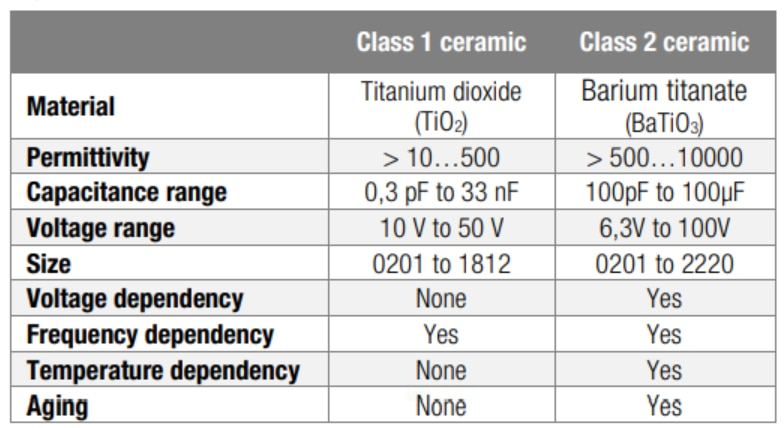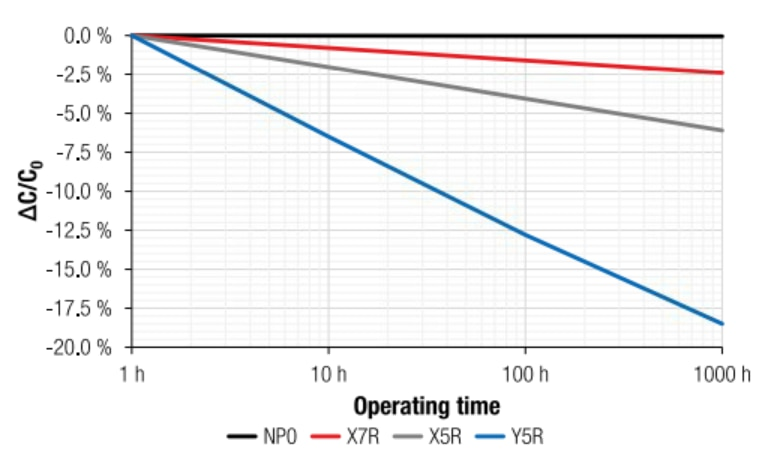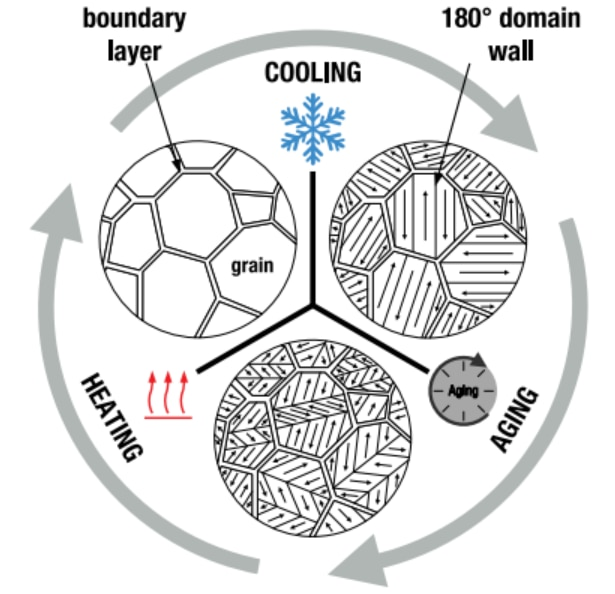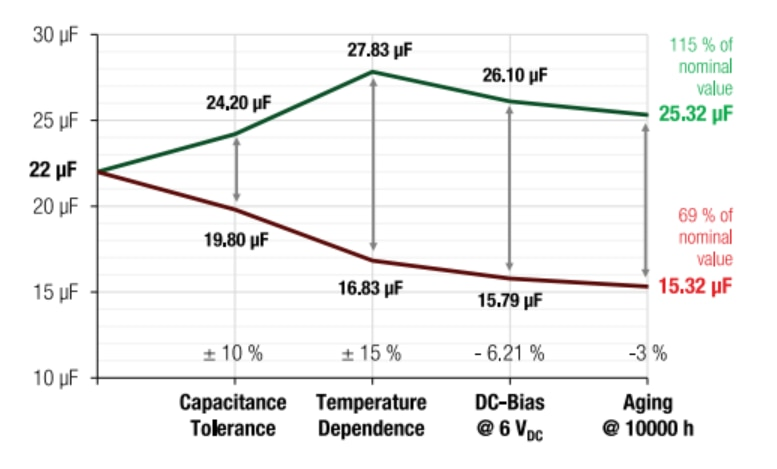
- +86 18120750932
- colin@xmsinuowei.com
- ja.xmsinuowei.com

1 クラス 1 およびクラス 2 MLCC の概要?
基本的に、MLCCS は 2 種類に区別できます。1 つはクラス 1 またはクラス 2 のセラミックで構成されるコンデンサです。表 1 に示すように、これらはいくつかの点で異なります。

表 1: Würth Elektronik eiSos のセラミックスの現在の技術的ステータスの概要
さまざまなセラミック クラスの特性と許容差は、IEC または EIA コーディングによって定義されます。アプリケーションに応じて、フィルタなどのアプリケーションで望ましい性能を達成するには、一定量の静電容量が必要です。したがって、アプリケーションで使用するときに望ましい動作を保証するために、個々のコンポーネントのプロパティを比較することが重要です。また、高静電容量の MLCC では、その高静電容量を利用できるのは、経年劣化が進み、温度や電圧による静電容量の損失が大きくなるという欠点があることにも注意してください。
2 老化の定義
老化とは、時間の経過とともに特定の特性が変化するプロセスです。チタン酸バリウムなどの強誘電体材料もこのプロセスの対象となります。誘電体 (この場合はチタン酸バリウム) の結晶構造は、温度および時間とともに変化します。このイベントによって容量が変化するか、より正確には減少するため、これは経年劣化と考えられます。経年劣化のもう 1 つの結果は損失係数の増加であり、損失係数は着実に大きくなります。経年劣化は通常、10 年ごとの静電容量の損失の割合で表されます。これは、10 時間あたり (1 ~ 10、10 ~ 100、100 ~ 1000 など)、X5R セラミックの場合は 1000 時間後約 6%、X7R セラミックの場合は 1000 時間後に約 2.5% の範囲にあります。結晶格子を再調整した後(たとえば、必要なだけ繰り返すことができる温度プロセスによって)、図1に示すように、エージングにより静電容量の損失が生じます。老化のプロセスは対数的であり、時間とともに減少します。ただし、対数スケールを使用すると、チャート上では線形に見えます。

図 1: 容量損失と動作時間の関係
3 チタン酸バリウムに時効が存在するのはなぜですか?
チタン酸バリウムの誘電率は、材料の分極率によって定義されます。さらに、エージングによって強誘電体ドメインが形成されます。自発分極の方向は、すべての双極子が「うまく」分極できないように変化します。2 つの隣接するドメインの双極子は同じ方向を向いていません。その結果、静電容量が減少します。解決策: 材料の再構成。経年劣化の影響は、時間、温度、電圧の影響を受けます。チタン酸バリウムは強誘電体材料であり、フェライトと同様に電気ドメインを持っているため、これらのドメインは係数時間で分割され、静電容量が減少します (図 2 を参照)。

図2:内部構造の変化
By tempering, the so-called preheating process (heating the material above the Curie temperature), the existing domains dissolve. Below the Curie temperature, the material then forms new large domains again, which in turn results in a high capacity. The thermal movement in the crystal lattice caused by the annealing process prevents the dipoles from aligning completely when an electric field is applied, thus reaching a kind of saturation.
4 How can aging be stopped?
The dielectric used in Class 2 MLCCs has ferroelectric properties. These material properties change when the Curie temperature is exceeded (as with ferromagnetic materials). Above this temperature, the dielectric has a highly symmetrical cubic crystal structure, while below the Curie temperature; the crystal structure has a less symmetrical (tetragonal) structure. The transition from the different phases (cubic to tetragonal etc.) always results in a maximum value of permittivity over this temperature range. To achieve a stable state, the atoms in the crystal lattice move under the influence of thermal vibration for a long time, even after the dielectric has cooled down below the Curie temperature (more and more domains are formed). However, when the capacitor is heated to a temperature above the Curie temperature, aging takes place, i.e. the capacity lost due to aging is regained and aging begins again from the point at which the capacitor cools down again. This temperature is ~125°C for barium titanate. Depending on how long the Curie temperature is exceeded, this results in the capacitance value that is set. According to the data sheet, the recommendation for preheating at 150°C is 1 hour. By this thermal treatment, the maximum 100% capacity of the component can be restored.
5 Effects of aging for the application
In a real application, which contains voltage and is operated at a certain ambient temperature, a reduction in capacity over time must generally be foreseen when using MLCCs. This is unavoidable and is caused by the base material used for Class 2 ceramics. It is now up to the design of the capacitor to compensate for this capacitance loss. A 100% test is performed after manufacture to ensure that all tolerances are met. Depending on storage time and storage conditions, these values may change over time. Due to the heat influence of the soldering process, the aging process is reset (see appendix, example measurement and reflow soldering process for a MLCC with the DateCode 2014). In applications where stable capacitance values are required, aging must be considered or a Class 1 MLCC must be used. If capacitors are used as output capacitors (e.g. in switching regulators), the effect of aging can be best compensated for, as in this case the capacitance fluctuations are in the low single-digit range and therefore have no negative effect on the function of the circuit. The resulting capacitance of an e.g. 22 µF X7R MLCC with all dependencies is shown in figure 3.

Figure 3: Real capacity considering all dependencies
6 Conclusion
The aging is recorded at room temperature (around 20 °C) and ~0 V as applied voltage. At room temperature and ~0 V ceramic capacitors have almost no temperature, DC bias and frequency influences that could influence aging. Below the Curie temperature and after applying a voltage, the existing ferroelectric properties polarize the molecules in a defined manner. The cubic structure becomes a tetragonal structure, which leads to a decrease in permittivity and thus in capacity. What now leads to aging? If the crystal structure of the ceramic is left at room temperature without load, randomly oriented domains are formed in which, in turn, non-directional dipoles are formed, which have a negative influence on the permittivity. These randomly oriented domains "grow" faster at first and then develop more slowly. Therefore, the loss of capacity is shown logarithmically. When a voltage is applied and the temperature is increased, the formation of randomly oriented domains slows down, since the dipoles are aligned in a defined manner by the electric field. In practice, this means that aging as shown in Figure 1 is a “worst case” figure. Since the decrease in capacity via DC bias and temperature is significantly higher than the expected aging, this is assumed a fixed value.
Source:element

オンラインサービス